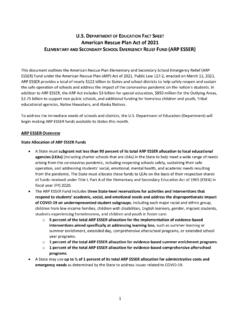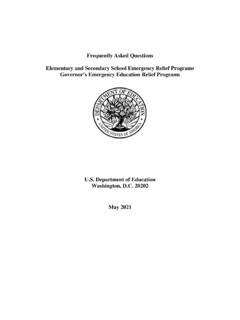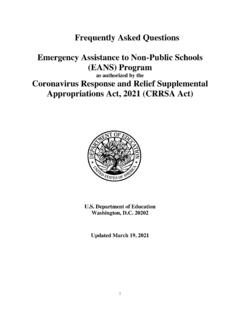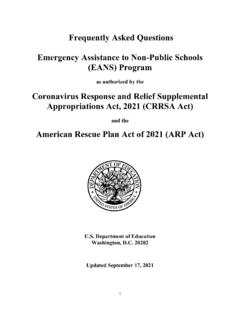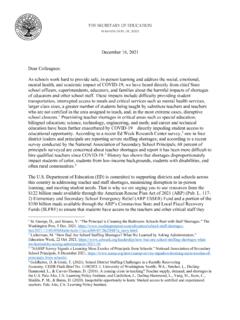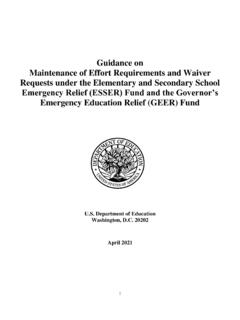Transcription of Strategies for Equitable Family Engagement
1 Strategies for Equitable Family Engagement Catherine Jacques Alma Villegas December 2018 1000 Thomas Jefferson Street NW Washington, DC 20007-3835 This document was produced by American Institutes for Research under Department of Education contract number ED-ESE-15-A-0006/0001. The content of this document does not necessarily reflect the views or policies of the Department of Education, nor does mention of trade names, commercial products, or organizations imply endorsement by the government. This document may contain the views and recommendations of various subject matter experts as well as hypertext links, contact addresses and websites to information created and maintained by other public and private organizations. The inclusion of links to resources and examples do not reflect their importance, nor is it intended to represent or be an endorsement by the Department of Education of any views expressed, or materials provided.
2 The Department of Education does not control or guarantee the accuracy, relevance, timeliness, or completeness of any outside information included in this document. Authorization to reproduce this document in whole or in part for educational purposes is granted. State Support Network Equitable Family Engagement ii The State Support Network would like to acknowledge the support of Marion Baldwin (American Institutes for Research), Lacy Woods (American Institutes for Research), Frances Frost ( Department of Education), and Porscheoy Brice ( Department of Education) in preparing this resource. State Support Network Equitable Family Engagement iii Contents Page About This Resource .. 1 Introduction .. 2 Making a Commitment to Equitable Family Engagement .. 4 Making Equitable Family Engagement Business as Usual .. 6 Building Relationships Between Staff and Families .. 9 Meaningfully Involving and Engaging Families and Trusted Community Advocates.
3 10 Engaging Outside of the School 12 Considerations for Implementing Equitable Family Engagement Strategies .. 13 Resources .. 14 References .. 14 State Support Network Equitable Family Engagement 1 About This Resource This resource provides an overview of evidence-based Strategies that schools and districts may use to promote Equitable Family Engagement practices. Organized around five categories of Equitable Family Engagement Strategies , this resource includes summaries of the research on Equitable Family Engagement as well as examples of school and district practices across the country, linking to publicly available information where possible. School and district leaders may use this resource to build staff knowledge around Equitable Family Engagement and inform strategy selection as part of implementation of the Elementary and Secondary Education Act of 1965 (ESEA), as amended by the Every Student Succeeds Act (ESSA). While this resource provides a broad overview of Equitable Family Engagement , it is meant to be informational rather than definitive or comprehensive.
4 defining Equitable Family Engagement Equitable Family Engagement focuses on meaningful Engagement activities and systems between schools and families that do not characterize or treat specific parent groups as deficient in their level of Engagement or approach to education (Day, 2013). This includes specific practices or approaches that reflect the values of a general group of families, as well as systems that foster tailored supports, flexible Engagement options, and coordination between families and schools. For many schools, Equitable Family Engagement includes a special focus on minority, immigrant, or refugee families. For parents, Equitable Family Engagement can include: A relationship with a trusted staff person or teacher who is approachable, friendly, receptive to concerns, and a champion for the student and Family . Perceptions that families are welcome and valued at the school. Receptivity, transparency, empathy, and flexibility from school staff regarding communication and collaborative efforts to support learning and success.
5 (Day, 2013; Ferguson, 2005; LaRocque, 2013) For school teachers and leaders, Equitable Family Engagement can include acknowledging and navigating cultural differences through communication and sensitivity, as well as overcoming other structural challenges or barriers (Olsen, Bhattacharya, & Scharf, 2006). This includes skills such as: Accepting and respecting different cultural differences around communication and values. Self-awareness regarding one s own culture and values. Understanding how various factors influence interpersonal dynamics and experiences. (NEA, 2008) State Support Network Equitable Family Engagement 2 Introduction Family Engagement is a regular practice at most schools and may include activities such as parent-teacher conferences, regular reports about student progress, parent volunteer activities, input on school decision making, or collaboration between teachers and families around meeting individual learning needs (Epstein & Salinas, 2004).
6 Family Engagement is intended to foster communication with parents about student performance and collaboratively support learning; Equitable Family Engagement describes conditions where all types of families are positively involved in their children s education. This often means ensuring that Family Engagement is Equitable , inclusive, accessible, and culturally competent ( , respecting and meeting the social, cultural, and linguistic norms and needs of families and students). Schools and districts that face challenges around effectively engaging specific types of families, especially those from different racial or cultural backgrounds, can work to address Family Engagement inequities by considering the needs of their communities and how to best engage Family members meaningfully in their school activities. A wide body of evidence emphasizes the importance of Family Engagement for student achievement and social development over time and makes a strong case that Engagement can be a powerful strategy for sustainable long-term student success.
7 Research shows a variety of links between effective Family Engagement and student success: Teacher- Family communication is linked to better homework completion, attention during instructional tasks, and class participation rates, as well as improved teacher-student interactions and student motivation (Kraft & Dougherty, 2013). Students whose families are involved in their school experiences are more likely to have higher grades and test scores, attend school regularly, have better social skills, show improved behavior, and adapt well to school (Henderson & Mapp, 2002). School-based Family Engagement activities ( , volunteer activities or Parent-Teacher Association involvement) have been shown to have a positive effect on student outcomes (Hill & Tyson, 2009). Students whose families help them make connections between their current school performance and their long-term goals ( , attending college, working in a specific profession) is correlated with higher achievement levels for these students in secondary school (Hill & Tyson, 2009).
8 Schools often face challenges implementing responsive Family Engagement Strategies and practices that consider the full range of culturally diverse populations in their communities; likewise, more immigrant parents report barriers to Engagement ( , language barriers) than non-immigrant families (De Luigi & Martelli, 2015; Turney & Kao, 2009). A wide variety of factors may contribute to barriers to Engagement that also vary across different cultures and groups ( , race, religion, class); therefore, a school wishing to improve Family Engagement may consider conducting a needs assessment or consulting experts to better understand the challenges specific to that school community (see the State Support Network Needs Assessment State Support Network Equitable Family Engagement 3 Guidebook for more information). However, several common challenges are documented in the research literature: Family members may not be able to attend school meetings or functions due to scheduling conflicts, time constraints (often involving childcare, commute time, or multiple jobs), and other challenges.
9 Family members (especially recent immigrants) may have had different, few, or no experiences with formal education. Family members who are recent immigrants, regardless of age, may be experiencing stress regarding cultural dissonance or major life changes. Family members may distrust public institutions and choose to limit interactions with school personnel or to participate in their children s education outside of the reach of the school system. Some immigrant and refugee families come from a culture where parents are not expected to be engaged with schools, but rather to entrust their children s education to outside experts. Educators may have limited time or capacity to engage in thoughtful or detailed interactions with families. Educators may communicate with families about problems but fail to offer guidance or information to help parents support students, especially in middle and high school. Educators may lack the preparation or administrative support to effectively engage with diverse families.
10 Educators may hold expectations for Family Engagement that do not realistically reflect the schedules or cultures of families. Educators may neglect to engage families based on perceptions that families do not wish to be involved, which can exacerbate communication challenges between families and school staff. (Hill & Tyson, 2009; Gonzalez-DeHass & Willems, 2003; zt rk, 2013; Stephens & Pate 2015) While there is an extensive body of research on general Family Engagement Strategies , many schools and districts need information about how schools engage all families equitably. The following sections outline Strategies and provide real-world examples across five major types of evidence-based Strategies for promoting Equitable Family engagement1 1 These categories are similar to those presented in the 2014 brief from the Reform Support Network, Strategies for Community Engagement . : Making a commitment to Equitable Family Engagement Making Equitable Family Engagement business as usual Building relationships between staff and families Meaningfully involving and engaging families and t rusted community advocates Engaging outside of the school buildingState Support Network Equitable Family Engagement 4 Making a Commitment to Equitable Family Engagement By making a clear and transparent commitment to Equitable Family Engagement in both public communications and leadership activities, school and district leaders can encourage school staff and families to build and strengthen communication and Engagement systems.
